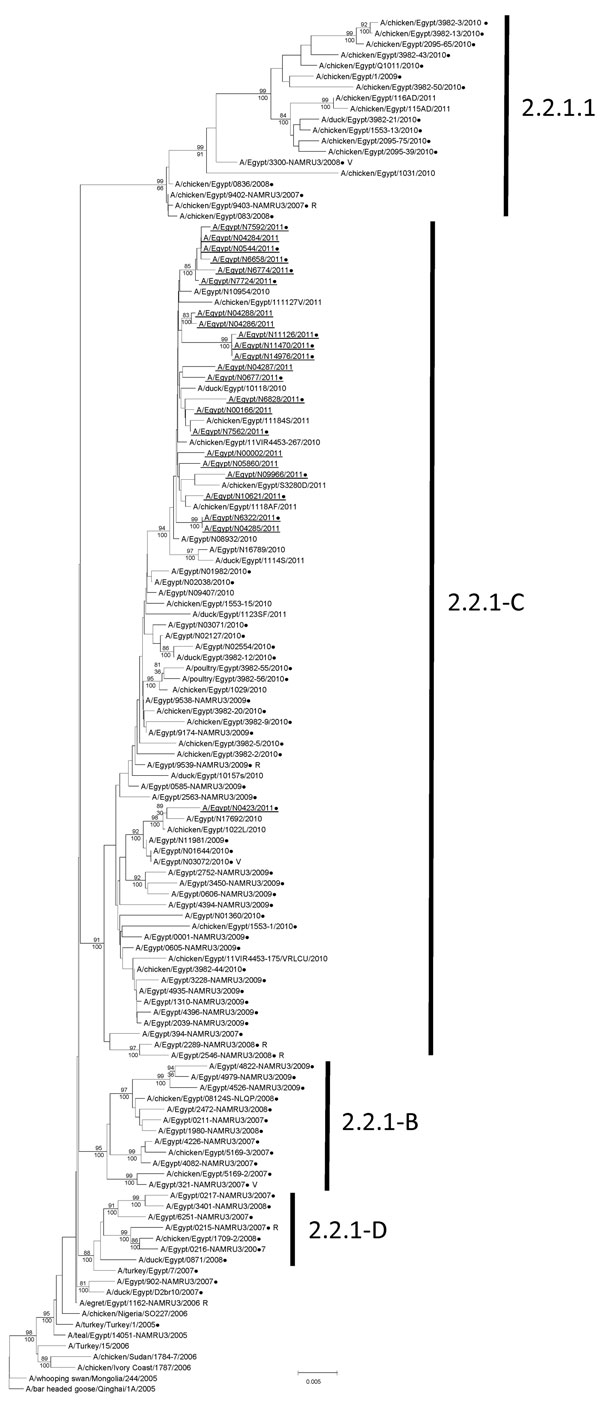Microevolution of Highly Pathogenic Avian Influenza A(H5N1) Viruses Isolated from Humans, Egypt, 2007–2011
Mary Younan
1, Mee Kian Poh
1, Emad Elassal
1, Todd Davis, Pierre Rivailler, Amanda L. Balish, Natosha Simpson, Joyce Jones, Varough Deyde, Rosette Loughlin, Ije Perry, Larisa Gubareva, Maha A. ElBadry, Shaun Truelove, Anne M. Gaynor, Emad Mohareb, Magdy Amin, Claire Cornelius, Guillermo Pimentel, Kenneth Earhart, Amel Naguib, Ahmed S. Abdelghani, Samir Refaey, Alexander I. Klimov, Ruben O. Donis

, and Amr Kandeel
Author affiliations: Author affiliations: US Naval Medical Research Unit No.3, Cairo, Egypt (M. Younan, E. Elassal, M.A. ElBadry, S. Truelove, A.M. Gaynor, E. Mohareb, C. Cornelius, G. Pimentel, K. Earhart); Centers for Disease Control and Prevention, Atlanta, Georgia, USA (M.K. Poh, T. Davis, P. Rivailler, A.L. Balish, N. Simpson, J. Jones, V. Deyde, R. Loughlin, I. Perry, L. Gubareva, A.I. Klimov, R.O. Donis); Cairo University, Cairo (M. Amin); Ministry of Health and Population, Cairo (A. Naguib, A.S. Abdelghani, S. Refaey, A. Kandeel)
Main Article
Figure 1

Figure 1. . . Phylogenetic tree of the influenza A(H5) virus hemagglutinin genes, clade 2.2.1, generated by neighbor-joining analysis. Subgroups of clade 2.2.1 are indicated on the right. Bootstrap values (>79) generated from 1,000 neighbor-joining replicates are shown above branches, and Bayesian posterior probabilities are shown below the branches at relevant nodes. Scale bar represents 0.002 nt substitutions per site. Viruses recommended by the World Health Organization for development of candidate pandemic vaccines are indicated with a V; viruses inoculated into ferrets to raise antiserum for hemagglutinin inhibition assays are indicated with an R. Underlined names denote 23 human viruses collected in 2011. Sequences used for full genome analysis in this study are annotated with a dot.
Main Article
Page created: December 20, 2012
Page updated: December 20, 2012
Page reviewed: December 20, 2012
The conclusions, findings, and opinions expressed by authors contributing to this journal do not necessarily reflect the official position of the U.S. Department of Health and Human Services, the Public Health Service, the Centers for Disease Control and Prevention, or the authors' affiliated institutions. Use of trade names is for identification only and does not imply endorsement by any of the groups named above.
